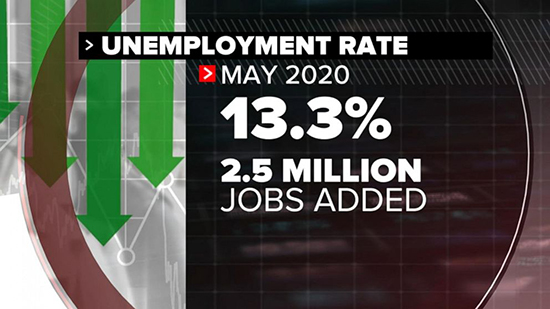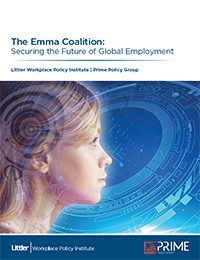

Looking Behind the Numbers: 2.5M Jobs in May!
With 30 million unemployed waiting on the sidelines, the Emma Coalition’s Michael Lotito discusses workplace transformation and what’s really happening to jobs
U.S financial firms spending $150 billion annually to automate 200,000 banking jobs —Forbes
Numbers look great, but…
On Friday afternoon, cheering accompanied the newest federal jobs report as 2.5 million jobs were added in May. However, as the Wall Street Journal reminded everyone: “Tens of millions remain out of work, and the unemployment rate, which fell to 13.3 percent from 14.7 percent in April, remains higher than in any previous postwar recession.”
But at least it is something to feel good about in 2020’s pandemic-flattened economic crisis. And don’t we all need a little something cheery these days?

However, what exactly were those 2.5 million jobs returning to work? The feds say restaurants, leisure and hospitality, construction, education, health services, and retail trade represented the bulk of the jobs. Certainly, the overwhelming majority are not the highest paying jobs around or workplaces where good, middle-class careers can be built and maintained. They also represent jobs exactly in the sweet spot that robots and automation have targeted for years, yet haven’t quite gotten around to mastering as of yet.
Amazon in May finished hiring 100,000 new workers for these not-so-great jobs and is seeking yet another 75,000. WalMart needs another 50,000, as does FedEx, as does Albertson’s, as does CVS. Plentiful is employment that, unless you work a ton of overtime or have a side gig, won’t fully support the workers who are working them, and most certainly cannot provide for a family.
Then again, a Wells Fargo report sees as many as 200,000 jobs in the financial industry getting axed; good jobs like back office, bank branch, and corporate employees, including, but to a lesser extent, tech, sales, advising and consulting. Mike Mayo, a senior analyst at Wells Fargo Securities, said that the “$150 billion annually that the country’s finance firms are spending on tech—more than any other industry—will lead to lower costs, with employee compensation accounting for half of all bank expenses.”
That’s a rather quiet $150 billion annually in Robotic Process Automation and fintech moving in while employees are moving out. These former employees will find alternative work doing similar jobs somewhere else in the financial industry very hard to find, if at all.
“McKinsey & Co. said in May that it expects the headcount for front-office workers —the bankers and traders historically seen as among finance firms’ most valuable assets—to drop by almost a third with the rise of robots.”
So, on the one hand, there seems to be tons of low-paying, low-end jobs where employees get trapped until eventually automation and robots finally arrive to drive them out. What then to do with all those displaced employees?
On the other hand, multi-billions in automation tech are hollowing out good jobs from entire industries, like banking. What then to do about good-paying, career-path jobs that go poof! in the face of automation?

The Emma effect
Workers by the millions are being caught up in an immense squeeze play being played out between time and technology. Michael Lotito, CEO and co-founder of the Emma Coalition, is determined to help save workers from what he calls TIDE or Technology-Induced Displacement of Employees, which these days is being exacerbated by VIDE as well, Virus-Induced Displacement of Employees.
Between TIDE and VIDE, 30 million Americans find themselves without a job, some temporary, some permanently so.
Lotito, a long-time attorney with Littler Mendelson, is also the firm’s co-chair of the Workplace Policy Institute (WPI), and since 2018, founder and CEO of the Emma Coalition, a Littler supported, non-profit that the organization’s website says is “dedicated to educating the employer community and policymakers about the issues surrounding TIDE, and maximizing the economic and social benefits of TIDE for America’s companies and workers.”

Securing the Future of Global Employment
Although the Emma Coalition is a newbie organization, Lotito totes along deep experience in worker and workplace law, as well as wide connectivity to both industry and government. He’s well-traveled in the ways of work and workplaces, bosses and employees, careers and career seekers, and what it takes to keep all in harmony.
Lotito recently appeared on a ProjectHR podcast where he discussed TIDE/VIDE and the ways that the Emma Coalition is working to get workplaces and workers to reskill and reinvent themselves through life-long learning.
Click here for the ProjectHR podcast:
Notes from Lotito podcast:
Preparing Future Displaced Employees for Success
- Do a data analysis to identify job skills that are most at-risk and job skills that will be most in demand;
- For those who are not yet in the workforce: Redesign the K-12 educational system, to start teaching those relevant future skills.
- For those already in the workforce when TIDE affects them: Create Lifelong Learning Accounts (funded through governments and employer/employee contributions), which enables people to upskill over the course of their entire career, allowing them to better evolve with their jobs.
Address the critical questions:
- How do we engage with Universities and Community Colleges to create the online courses that allow for this upskilling;
- What are employer obligations to create these skills?
- What role do union and non-union apprenticeship programs play in creating these skills?
Addressing TIDE Today
- A few higher-end businesses have been thinking about TIDE for a long time, and already have programs in place to upskill employees and make these workforce transitions in a humane way. Unfortunately, these companies are few and far between.
- One of the casualties of the pandemic is our inability to focus on longer-term issues like TIDE.
- Washington State enacted legislation that created a special task force that studied the impact of TIDE in their state, they issued a report in December 2019, that serves as a great blueprint and a great best practice for other states to follow. But that task force’s funding expires in June of 2020, and may not be reauthorized as a result of the current health crisis.
- California announced that they would have a task force, but there’s been very little publicity about it. This was likely done in response to a Little Hoover Commission report , released in 2018, that said California was at an enormous risk for TIDE over the next few decades.
- The federal government did form a task force with different business leaders and stakeholders, but they were focused more on the immediate skill gaps (prior to COVID-19), rather than taking a long-term look at the future.
- The Emma Coalition has sent a letter to the Secretary of Labor, talking about reformulating an already-funded government program – the Workforce Innovation and Opportunity Act (WOIA) – to mandate that states need to undertake a TIDE-related workforce analysis as a condition of accessing WOIA funds.

